Analysis of the Racial and Religious Tolerance Act (Sociology)
VerifiedAdded on 2022/10/04
|10
|2724
|16
Essay
AI Summary
This sociology essay analyzes the Racial and Religious Tolerance Act of 2001 in Victoria, Australia. The essay begins with an introduction to freedom of expression and the context of the act, which aims to prohibit incitement of hatred based on race or religion. It explores the policy's scope, goals, and impact on the targeted population, including indigenous communities. The discussion delves into the effectiveness of the act, highlighting controversies and exceptions, and its implications for freedom of speech. The essay examines the act's impact on individuals, groups, and the nation, considering sociological concepts such as social conflict theory. It also discusses the structure of the act, agency, and the relationship between them, concluding that the act aims to combat unlawful conduct related to racial and religious vilification, enabling equal participation in society, and valuing freedom of expression.
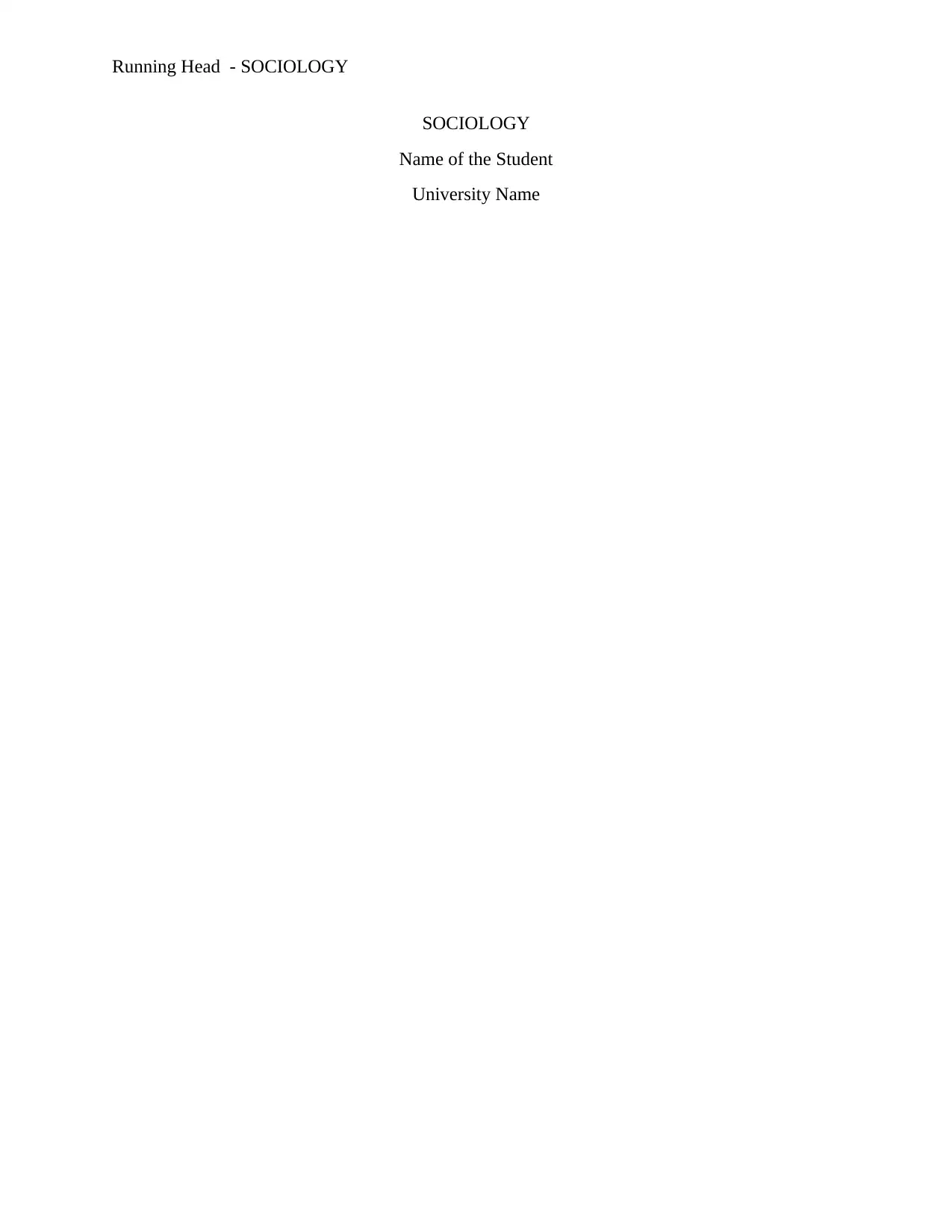
Running Head - SOCIOLOGY
SOCIOLOGY
Name of the Student
University Name
SOCIOLOGY
Name of the Student
University Name
Paraphrase This Document
Need a fresh take? Get an instant paraphrase of this document with our AI Paraphraser
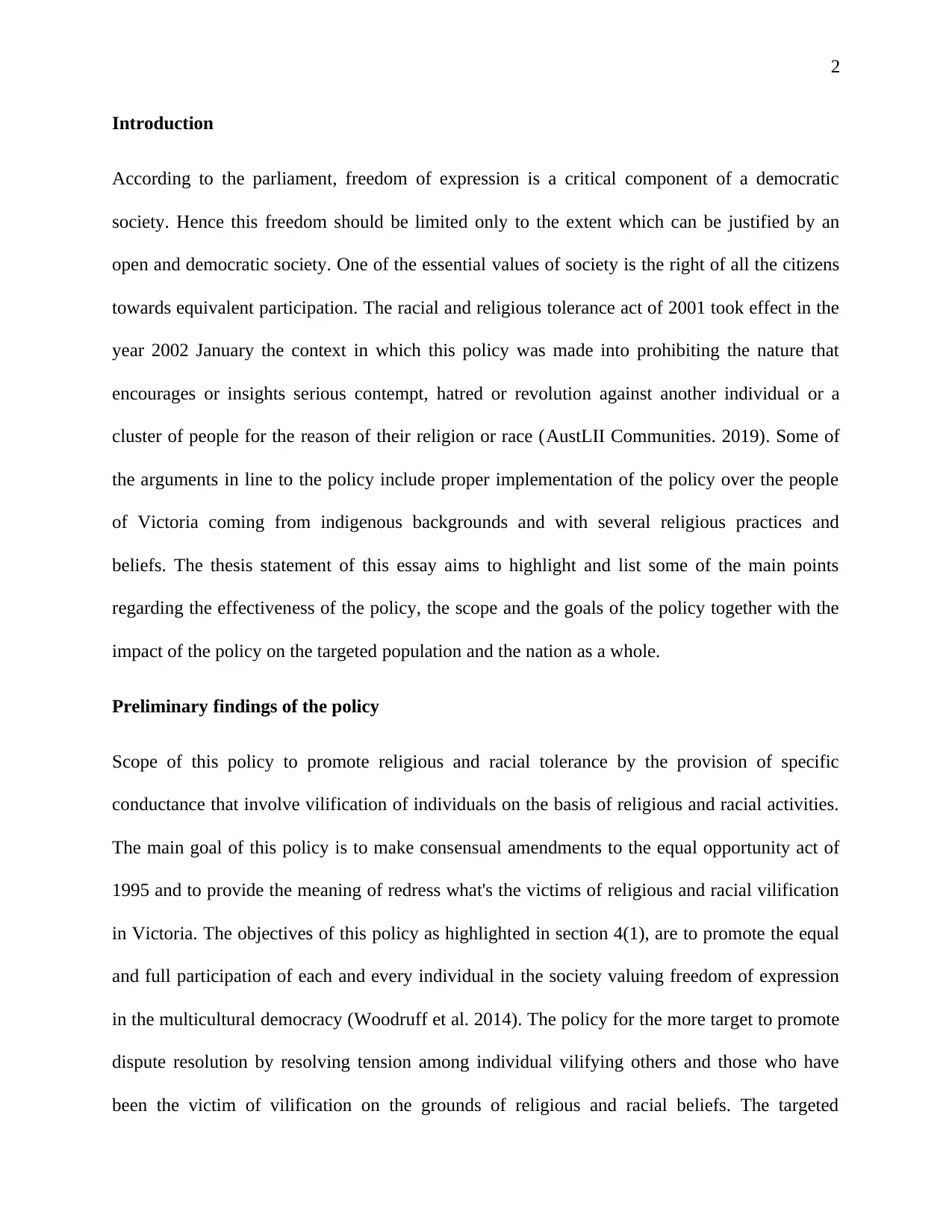
2
Introduction
According to the parliament, freedom of expression is a critical component of a democratic
society. Hence this freedom should be limited only to the extent which can be justified by an
open and democratic society. One of the essential values of society is the right of all the citizens
towards equivalent participation. The racial and religious tolerance act of 2001 took effect in the
year 2002 January the context in which this policy was made into prohibiting the nature that
encourages or insights serious contempt, hatred or revolution against another individual or a
cluster of people for the reason of their religion or race (AustLII Communities. 2019). Some of
the arguments in line to the policy include proper implementation of the policy over the people
of Victoria coming from indigenous backgrounds and with several religious practices and
beliefs. The thesis statement of this essay aims to highlight and list some of the main points
regarding the effectiveness of the policy, the scope and the goals of the policy together with the
impact of the policy on the targeted population and the nation as a whole.
Preliminary findings of the policy
Scope of this policy to promote religious and racial tolerance by the provision of specific
conductance that involve vilification of individuals on the basis of religious and racial activities.
The main goal of this policy is to make consensual amendments to the equal opportunity act of
1995 and to provide the meaning of redress what's the victims of religious and racial vilification
in Victoria. The objectives of this policy as highlighted in section 4(1), are to promote the equal
and full participation of each and every individual in the society valuing freedom of expression
in the multicultural democracy (Woodruff et al. 2014). The policy for the more target to promote
dispute resolution by resolving tension among individual vilifying others and those who have
been the victim of vilification on the grounds of religious and racial beliefs. The targeted
Introduction
According to the parliament, freedom of expression is a critical component of a democratic
society. Hence this freedom should be limited only to the extent which can be justified by an
open and democratic society. One of the essential values of society is the right of all the citizens
towards equivalent participation. The racial and religious tolerance act of 2001 took effect in the
year 2002 January the context in which this policy was made into prohibiting the nature that
encourages or insights serious contempt, hatred or revolution against another individual or a
cluster of people for the reason of their religion or race (AustLII Communities. 2019). Some of
the arguments in line to the policy include proper implementation of the policy over the people
of Victoria coming from indigenous backgrounds and with several religious practices and
beliefs. The thesis statement of this essay aims to highlight and list some of the main points
regarding the effectiveness of the policy, the scope and the goals of the policy together with the
impact of the policy on the targeted population and the nation as a whole.
Preliminary findings of the policy
Scope of this policy to promote religious and racial tolerance by the provision of specific
conductance that involve vilification of individuals on the basis of religious and racial activities.
The main goal of this policy is to make consensual amendments to the equal opportunity act of
1995 and to provide the meaning of redress what's the victims of religious and racial vilification
in Victoria. The objectives of this policy as highlighted in section 4(1), are to promote the equal
and full participation of each and every individual in the society valuing freedom of expression
in the multicultural democracy (Woodruff et al. 2014). The policy for the more target to promote
dispute resolution by resolving tension among individual vilifying others and those who have
been the victim of vilification on the grounds of religious and racial beliefs. The targeted
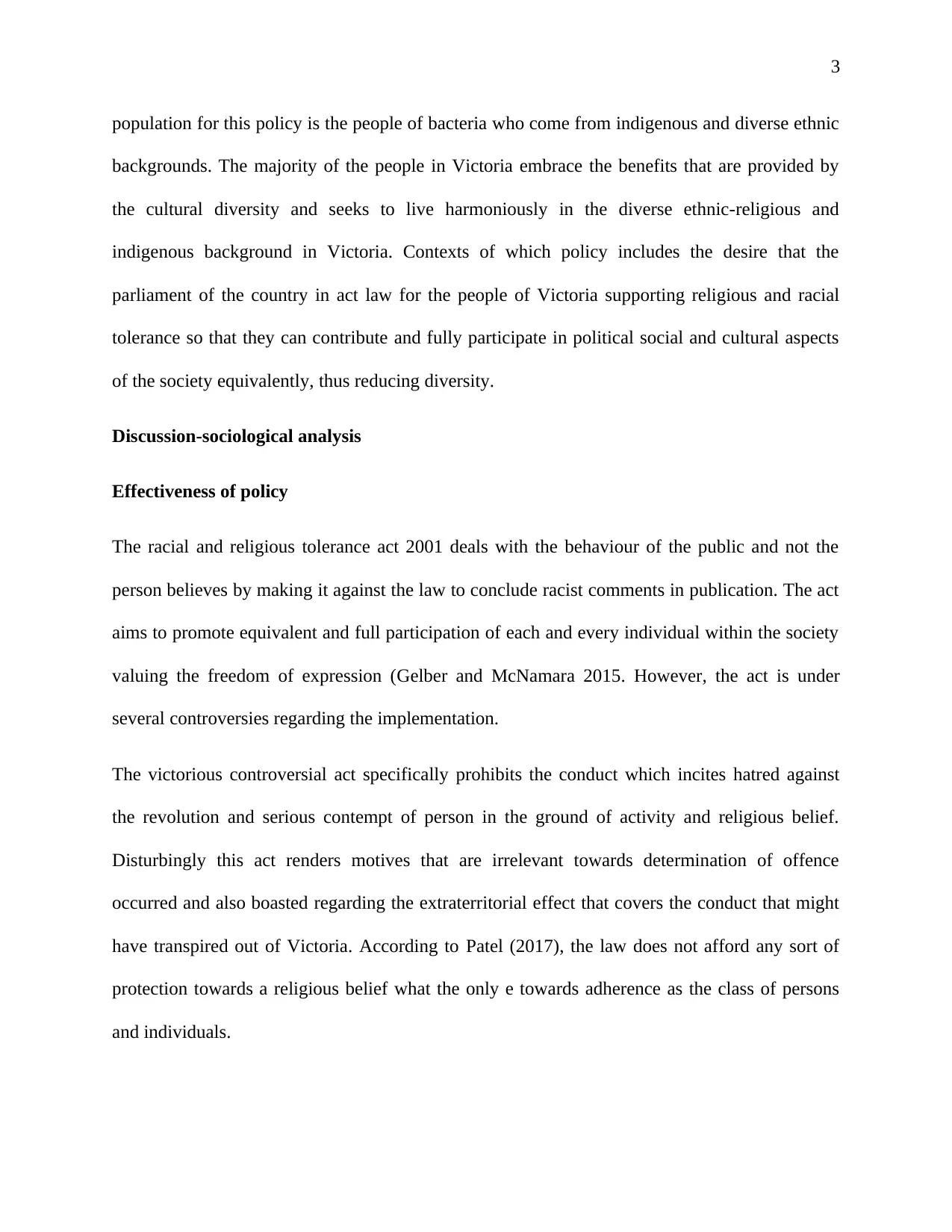
3
population for this policy is the people of bacteria who come from indigenous and diverse ethnic
backgrounds. The majority of the people in Victoria embrace the benefits that are provided by
the cultural diversity and seeks to live harmoniously in the diverse ethnic-religious and
indigenous background in Victoria. Contexts of which policy includes the desire that the
parliament of the country in act law for the people of Victoria supporting religious and racial
tolerance so that they can contribute and fully participate in political social and cultural aspects
of the society equivalently, thus reducing diversity.
Discussion-sociological analysis
Effectiveness of policy
The racial and religious tolerance act 2001 deals with the behaviour of the public and not the
person believes by making it against the law to conclude racist comments in publication. The act
aims to promote equivalent and full participation of each and every individual within the society
valuing the freedom of expression (Gelber and McNamara 2015. However, the act is under
several controversies regarding the implementation.
The victorious controversial act specifically prohibits the conduct which incites hatred against
the revolution and serious contempt of person in the ground of activity and religious belief.
Disturbingly this act renders motives that are irrelevant towards determination of offence
occurred and also boasted regarding the extraterritorial effect that covers the conduct that might
have transpired out of Victoria. According to Patel (2017), the law does not afford any sort of
protection towards a religious belief what the only e towards adherence as the class of persons
and individuals.
population for this policy is the people of bacteria who come from indigenous and diverse ethnic
backgrounds. The majority of the people in Victoria embrace the benefits that are provided by
the cultural diversity and seeks to live harmoniously in the diverse ethnic-religious and
indigenous background in Victoria. Contexts of which policy includes the desire that the
parliament of the country in act law for the people of Victoria supporting religious and racial
tolerance so that they can contribute and fully participate in political social and cultural aspects
of the society equivalently, thus reducing diversity.
Discussion-sociological analysis
Effectiveness of policy
The racial and religious tolerance act 2001 deals with the behaviour of the public and not the
person believes by making it against the law to conclude racist comments in publication. The act
aims to promote equivalent and full participation of each and every individual within the society
valuing the freedom of expression (Gelber and McNamara 2015. However, the act is under
several controversies regarding the implementation.
The victorious controversial act specifically prohibits the conduct which incites hatred against
the revolution and serious contempt of person in the ground of activity and religious belief.
Disturbingly this act renders motives that are irrelevant towards determination of offence
occurred and also boasted regarding the extraterritorial effect that covers the conduct that might
have transpired out of Victoria. According to Patel (2017), the law does not afford any sort of
protection towards a religious belief what the only e towards adherence as the class of persons
and individuals.
⊘ This is a preview!⊘
Do you want full access?
Subscribe today to unlock all pages.

Trusted by 1+ million students worldwide
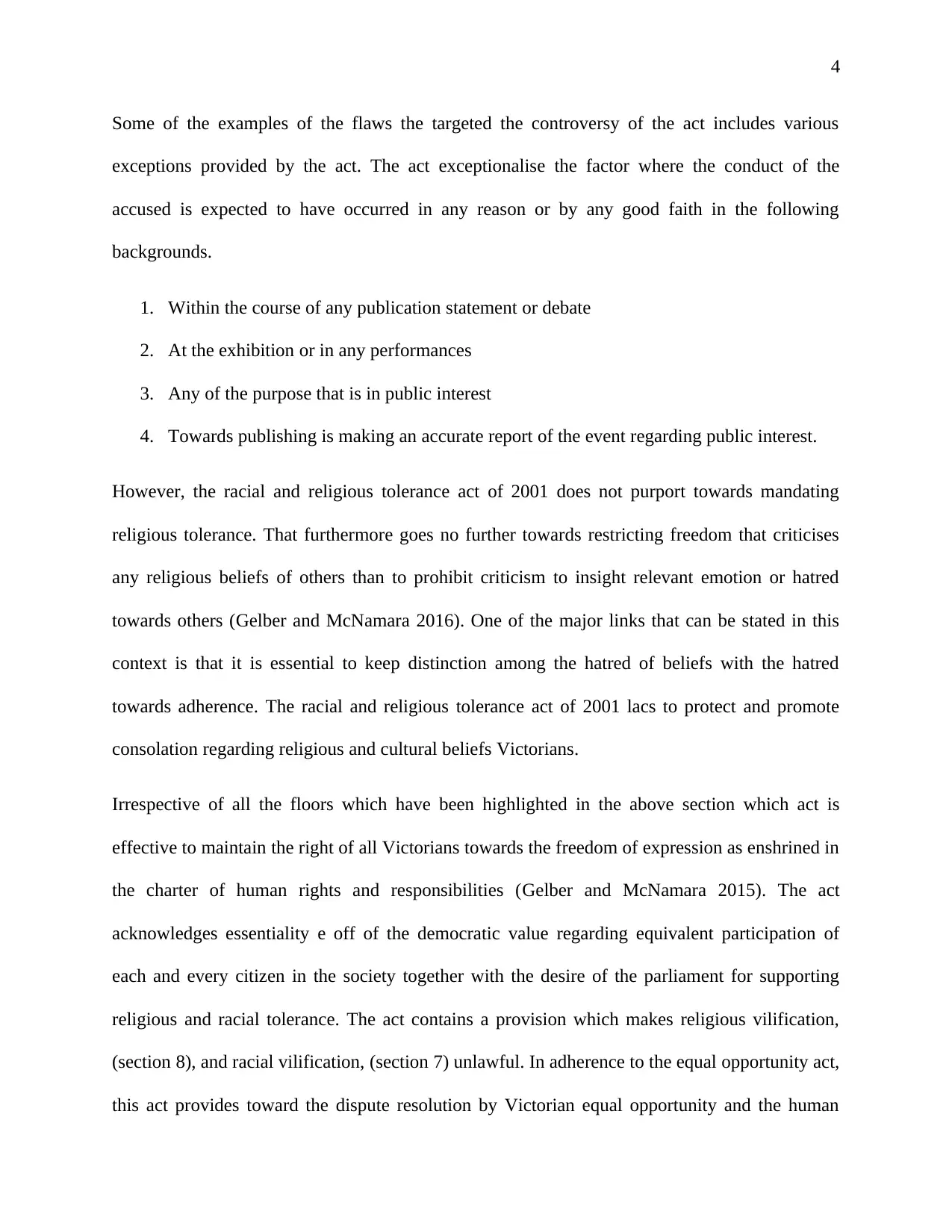
4
Some of the examples of the flaws the targeted the controversy of the act includes various
exceptions provided by the act. The act exceptionalise the factor where the conduct of the
accused is expected to have occurred in any reason or by any good faith in the following
backgrounds.
1. Within the course of any publication statement or debate
2. At the exhibition or in any performances
3. Any of the purpose that is in public interest
4. Towards publishing is making an accurate report of the event regarding public interest.
However, the racial and religious tolerance act of 2001 does not purport towards mandating
religious tolerance. That furthermore goes no further towards restricting freedom that criticises
any religious beliefs of others than to prohibit criticism to insight relevant emotion or hatred
towards others (Gelber and McNamara 2016). One of the major links that can be stated in this
context is that it is essential to keep distinction among the hatred of beliefs with the hatred
towards adherence. The racial and religious tolerance act of 2001 lacs to protect and promote
consolation regarding religious and cultural beliefs Victorians.
Irrespective of all the floors which have been highlighted in the above section which act is
effective to maintain the right of all Victorians towards the freedom of expression as enshrined in
the charter of human rights and responsibilities (Gelber and McNamara 2015). The act
acknowledges essentiality e off of the democratic value regarding equivalent participation of
each and every citizen in the society together with the desire of the parliament for supporting
religious and racial tolerance. The act contains a provision which makes religious vilification,
(section 8), and racial vilification, (section 7) unlawful. In adherence to the equal opportunity act,
this act provides toward the dispute resolution by Victorian equal opportunity and the human
Some of the examples of the flaws the targeted the controversy of the act includes various
exceptions provided by the act. The act exceptionalise the factor where the conduct of the
accused is expected to have occurred in any reason or by any good faith in the following
backgrounds.
1. Within the course of any publication statement or debate
2. At the exhibition or in any performances
3. Any of the purpose that is in public interest
4. Towards publishing is making an accurate report of the event regarding public interest.
However, the racial and religious tolerance act of 2001 does not purport towards mandating
religious tolerance. That furthermore goes no further towards restricting freedom that criticises
any religious beliefs of others than to prohibit criticism to insight relevant emotion or hatred
towards others (Gelber and McNamara 2016). One of the major links that can be stated in this
context is that it is essential to keep distinction among the hatred of beliefs with the hatred
towards adherence. The racial and religious tolerance act of 2001 lacs to protect and promote
consolation regarding religious and cultural beliefs Victorians.
Irrespective of all the floors which have been highlighted in the above section which act is
effective to maintain the right of all Victorians towards the freedom of expression as enshrined in
the charter of human rights and responsibilities (Gelber and McNamara 2015). The act
acknowledges essentiality e off of the democratic value regarding equivalent participation of
each and every citizen in the society together with the desire of the parliament for supporting
religious and racial tolerance. The act contains a provision which makes religious vilification,
(section 8), and racial vilification, (section 7) unlawful. In adherence to the equal opportunity act,
this act provides toward the dispute resolution by Victorian equal opportunity and the human
Paraphrase This Document
Need a fresh take? Get an instant paraphrase of this document with our AI Paraphraser
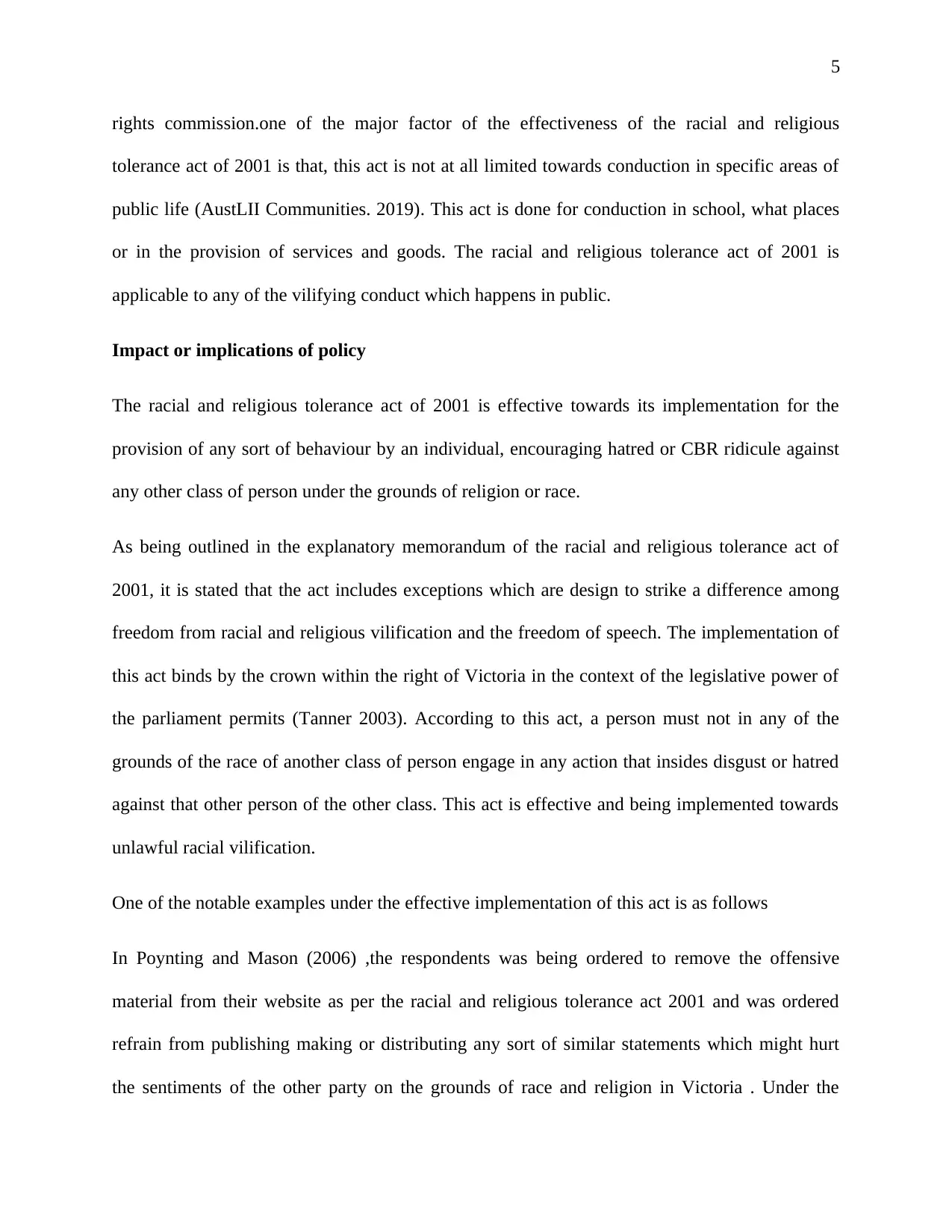
5
rights commission.one of the major factor of the effectiveness of the racial and religious
tolerance act of 2001 is that, this act is not at all limited towards conduction in specific areas of
public life (AustLII Communities. 2019). This act is done for conduction in school, what places
or in the provision of services and goods. The racial and religious tolerance act of 2001 is
applicable to any of the vilifying conduct which happens in public.
Impact or implications of policy
The racial and religious tolerance act of 2001 is effective towards its implementation for the
provision of any sort of behaviour by an individual, encouraging hatred or CBR ridicule against
any other class of person under the grounds of religion or race.
As being outlined in the explanatory memorandum of the racial and religious tolerance act of
2001, it is stated that the act includes exceptions which are design to strike a difference among
freedom from racial and religious vilification and the freedom of speech. The implementation of
this act binds by the crown within the right of Victoria in the context of the legislative power of
the parliament permits (Tanner 2003). According to this act, a person must not in any of the
grounds of the race of another class of person engage in any action that insides disgust or hatred
against that other person of the other class. This act is effective and being implemented towards
unlawful racial vilification.
One of the notable examples under the effective implementation of this act is as follows
In Poynting and Mason (2006) ,the respondents was being ordered to remove the offensive
material from their website as per the racial and religious tolerance act 2001 and was ordered
refrain from publishing making or distributing any sort of similar statements which might hurt
the sentiments of the other party on the grounds of race and religion in Victoria . Under the
rights commission.one of the major factor of the effectiveness of the racial and religious
tolerance act of 2001 is that, this act is not at all limited towards conduction in specific areas of
public life (AustLII Communities. 2019). This act is done for conduction in school, what places
or in the provision of services and goods. The racial and religious tolerance act of 2001 is
applicable to any of the vilifying conduct which happens in public.
Impact or implications of policy
The racial and religious tolerance act of 2001 is effective towards its implementation for the
provision of any sort of behaviour by an individual, encouraging hatred or CBR ridicule against
any other class of person under the grounds of religion or race.
As being outlined in the explanatory memorandum of the racial and religious tolerance act of
2001, it is stated that the act includes exceptions which are design to strike a difference among
freedom from racial and religious vilification and the freedom of speech. The implementation of
this act binds by the crown within the right of Victoria in the context of the legislative power of
the parliament permits (Tanner 2003). According to this act, a person must not in any of the
grounds of the race of another class of person engage in any action that insides disgust or hatred
against that other person of the other class. This act is effective and being implemented towards
unlawful racial vilification.
One of the notable examples under the effective implementation of this act is as follows
In Poynting and Mason (2006) ,the respondents was being ordered to remove the offensive
material from their website as per the racial and religious tolerance act 2001 and was ordered
refrain from publishing making or distributing any sort of similar statements which might hurt
the sentiments of the other party on the grounds of race and religion in Victoria . Under the
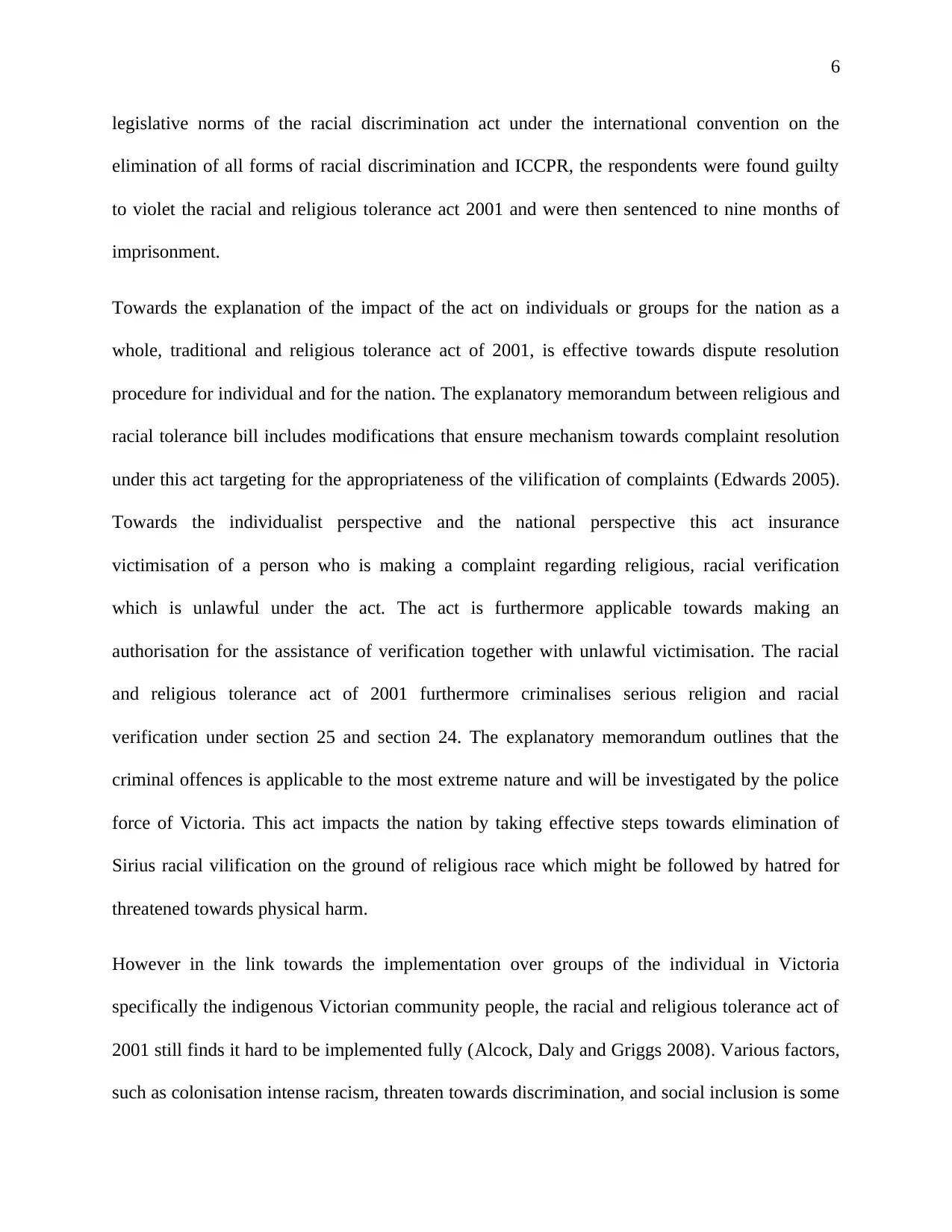
6
legislative norms of the racial discrimination act under the international convention on the
elimination of all forms of racial discrimination and ICCPR, the respondents were found guilty
to violet the racial and religious tolerance act 2001 and were then sentenced to nine months of
imprisonment.
Towards the explanation of the impact of the act on individuals or groups for the nation as a
whole, traditional and religious tolerance act of 2001, is effective towards dispute resolution
procedure for individual and for the nation. The explanatory memorandum between religious and
racial tolerance bill includes modifications that ensure mechanism towards complaint resolution
under this act targeting for the appropriateness of the vilification of complaints (Edwards 2005).
Towards the individualist perspective and the national perspective this act insurance
victimisation of a person who is making a complaint regarding religious, racial verification
which is unlawful under the act. The act is furthermore applicable towards making an
authorisation for the assistance of verification together with unlawful victimisation. The racial
and religious tolerance act of 2001 furthermore criminalises serious religion and racial
verification under section 25 and section 24. The explanatory memorandum outlines that the
criminal offences is applicable to the most extreme nature and will be investigated by the police
force of Victoria. This act impacts the nation by taking effective steps towards elimination of
Sirius racial vilification on the ground of religious race which might be followed by hatred for
threatened towards physical harm.
However in the link towards the implementation over groups of the individual in Victoria
specifically the indigenous Victorian community people, the racial and religious tolerance act of
2001 still finds it hard to be implemented fully (Alcock, Daly and Griggs 2008). Various factors,
such as colonisation intense racism, threaten towards discrimination, and social inclusion is some
legislative norms of the racial discrimination act under the international convention on the
elimination of all forms of racial discrimination and ICCPR, the respondents were found guilty
to violet the racial and religious tolerance act 2001 and were then sentenced to nine months of
imprisonment.
Towards the explanation of the impact of the act on individuals or groups for the nation as a
whole, traditional and religious tolerance act of 2001, is effective towards dispute resolution
procedure for individual and for the nation. The explanatory memorandum between religious and
racial tolerance bill includes modifications that ensure mechanism towards complaint resolution
under this act targeting for the appropriateness of the vilification of complaints (Edwards 2005).
Towards the individualist perspective and the national perspective this act insurance
victimisation of a person who is making a complaint regarding religious, racial verification
which is unlawful under the act. The act is furthermore applicable towards making an
authorisation for the assistance of verification together with unlawful victimisation. The racial
and religious tolerance act of 2001 furthermore criminalises serious religion and racial
verification under section 25 and section 24. The explanatory memorandum outlines that the
criminal offences is applicable to the most extreme nature and will be investigated by the police
force of Victoria. This act impacts the nation by taking effective steps towards elimination of
Sirius racial vilification on the ground of religious race which might be followed by hatred for
threatened towards physical harm.
However in the link towards the implementation over groups of the individual in Victoria
specifically the indigenous Victorian community people, the racial and religious tolerance act of
2001 still finds it hard to be implemented fully (Alcock, Daly and Griggs 2008). Various factors,
such as colonisation intense racism, threaten towards discrimination, and social inclusion is some
⊘ This is a preview!⊘
Do you want full access?
Subscribe today to unlock all pages.

Trusted by 1+ million students worldwide
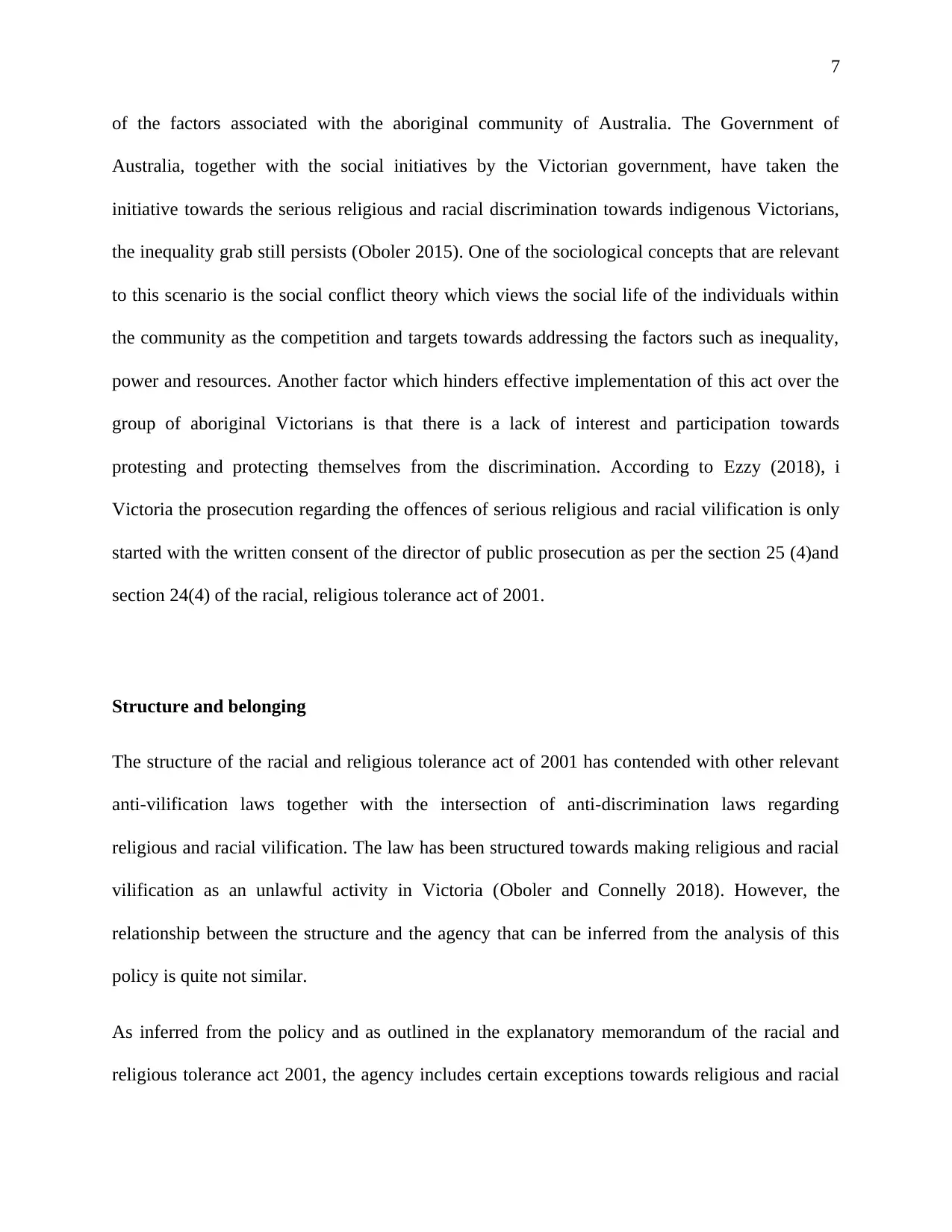
7
of the factors associated with the aboriginal community of Australia. The Government of
Australia, together with the social initiatives by the Victorian government, have taken the
initiative towards the serious religious and racial discrimination towards indigenous Victorians,
the inequality grab still persists (Oboler 2015). One of the sociological concepts that are relevant
to this scenario is the social conflict theory which views the social life of the individuals within
the community as the competition and targets towards addressing the factors such as inequality,
power and resources. Another factor which hinders effective implementation of this act over the
group of aboriginal Victorians is that there is a lack of interest and participation towards
protesting and protecting themselves from the discrimination. According to Ezzy (2018), i
Victoria the prosecution regarding the offences of serious religious and racial vilification is only
started with the written consent of the director of public prosecution as per the section 25 (4)and
section 24(4) of the racial, religious tolerance act of 2001.
Structure and belonging
The structure of the racial and religious tolerance act of 2001 has contended with other relevant
anti-vilification laws together with the intersection of anti-discrimination laws regarding
religious and racial vilification. The law has been structured towards making religious and racial
vilification as an unlawful activity in Victoria (Oboler and Connelly 2018). However, the
relationship between the structure and the agency that can be inferred from the analysis of this
policy is quite not similar.
As inferred from the policy and as outlined in the explanatory memorandum of the racial and
religious tolerance act 2001, the agency includes certain exceptions towards religious and racial
of the factors associated with the aboriginal community of Australia. The Government of
Australia, together with the social initiatives by the Victorian government, have taken the
initiative towards the serious religious and racial discrimination towards indigenous Victorians,
the inequality grab still persists (Oboler 2015). One of the sociological concepts that are relevant
to this scenario is the social conflict theory which views the social life of the individuals within
the community as the competition and targets towards addressing the factors such as inequality,
power and resources. Another factor which hinders effective implementation of this act over the
group of aboriginal Victorians is that there is a lack of interest and participation towards
protesting and protecting themselves from the discrimination. According to Ezzy (2018), i
Victoria the prosecution regarding the offences of serious religious and racial vilification is only
started with the written consent of the director of public prosecution as per the section 25 (4)and
section 24(4) of the racial, religious tolerance act of 2001.
Structure and belonging
The structure of the racial and religious tolerance act of 2001 has contended with other relevant
anti-vilification laws together with the intersection of anti-discrimination laws regarding
religious and racial vilification. The law has been structured towards making religious and racial
vilification as an unlawful activity in Victoria (Oboler and Connelly 2018). However, the
relationship between the structure and the agency that can be inferred from the analysis of this
policy is quite not similar.
As inferred from the policy and as outlined in the explanatory memorandum of the racial and
religious tolerance act 2001, the agency includes certain exceptions towards religious and racial
Paraphrase This Document
Need a fresh take? Get an instant paraphrase of this document with our AI Paraphraser
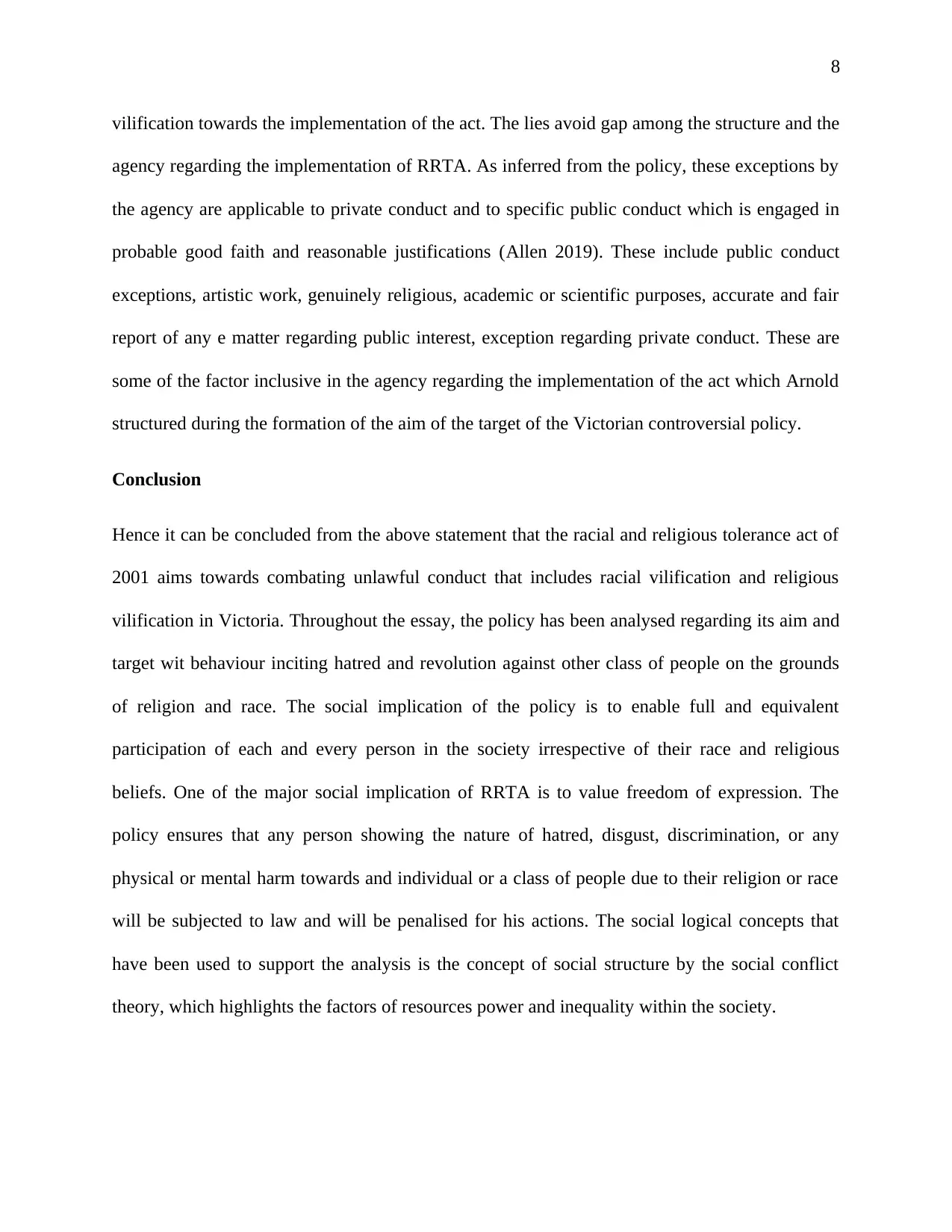
8
vilification towards the implementation of the act. The lies avoid gap among the structure and the
agency regarding the implementation of RRTA. As inferred from the policy, these exceptions by
the agency are applicable to private conduct and to specific public conduct which is engaged in
probable good faith and reasonable justifications (Allen 2019). These include public conduct
exceptions, artistic work, genuinely religious, academic or scientific purposes, accurate and fair
report of any e matter regarding public interest, exception regarding private conduct. These are
some of the factor inclusive in the agency regarding the implementation of the act which Arnold
structured during the formation of the aim of the target of the Victorian controversial policy.
Conclusion
Hence it can be concluded from the above statement that the racial and religious tolerance act of
2001 aims towards combating unlawful conduct that includes racial vilification and religious
vilification in Victoria. Throughout the essay, the policy has been analysed regarding its aim and
target wit behaviour inciting hatred and revolution against other class of people on the grounds
of religion and race. The social implication of the policy is to enable full and equivalent
participation of each and every person in the society irrespective of their race and religious
beliefs. One of the major social implication of RRTA is to value freedom of expression. The
policy ensures that any person showing the nature of hatred, disgust, discrimination, or any
physical or mental harm towards and individual or a class of people due to their religion or race
will be subjected to law and will be penalised for his actions. The social logical concepts that
have been used to support the analysis is the concept of social structure by the social conflict
theory, which highlights the factors of resources power and inequality within the society.
vilification towards the implementation of the act. The lies avoid gap among the structure and the
agency regarding the implementation of RRTA. As inferred from the policy, these exceptions by
the agency are applicable to private conduct and to specific public conduct which is engaged in
probable good faith and reasonable justifications (Allen 2019). These include public conduct
exceptions, artistic work, genuinely religious, academic or scientific purposes, accurate and fair
report of any e matter regarding public interest, exception regarding private conduct. These are
some of the factor inclusive in the agency regarding the implementation of the act which Arnold
structured during the formation of the aim of the target of the Victorian controversial policy.
Conclusion
Hence it can be concluded from the above statement that the racial and religious tolerance act of
2001 aims towards combating unlawful conduct that includes racial vilification and religious
vilification in Victoria. Throughout the essay, the policy has been analysed regarding its aim and
target wit behaviour inciting hatred and revolution against other class of people on the grounds
of religion and race. The social implication of the policy is to enable full and equivalent
participation of each and every person in the society irrespective of their race and religious
beliefs. One of the major social implication of RRTA is to value freedom of expression. The
policy ensures that any person showing the nature of hatred, disgust, discrimination, or any
physical or mental harm towards and individual or a class of people due to their religion or race
will be subjected to law and will be penalised for his actions. The social logical concepts that
have been used to support the analysis is the concept of social structure by the social conflict
theory, which highlights the factors of resources power and inequality within the society.
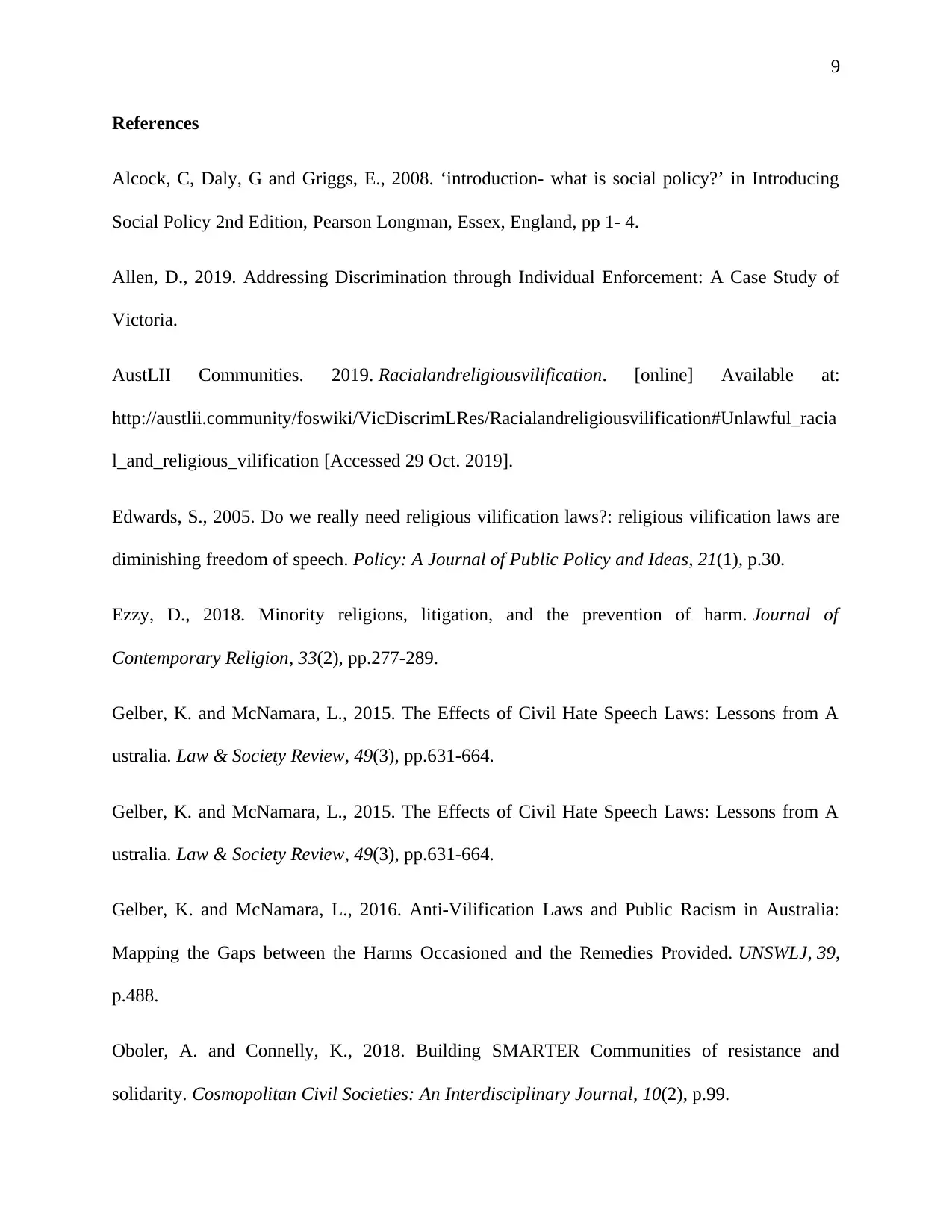
9
References
Alcock, C, Daly, G and Griggs, E., 2008. ‘introduction- what is social policy?’ in Introducing
Social Policy 2nd Edition, Pearson Longman, Essex, England, pp 1- 4.
Allen, D., 2019. Addressing Discrimination through Individual Enforcement: A Case Study of
Victoria.
AustLII Communities. 2019. Racialandreligiousvilification. [online] Available at:
http://austlii.community/foswiki/VicDiscrimLRes/Racialandreligiousvilification#Unlawful_racia
l_and_religious_vilification [Accessed 29 Oct. 2019].
Edwards, S., 2005. Do we really need religious vilification laws?: religious vilification laws are
diminishing freedom of speech. Policy: A Journal of Public Policy and Ideas, 21(1), p.30.
Ezzy, D., 2018. Minority religions, litigation, and the prevention of harm. Journal of
Contemporary Religion, 33(2), pp.277-289.
Gelber, K. and McNamara, L., 2015. The Effects of Civil Hate Speech Laws: Lessons from A
ustralia. Law & Society Review, 49(3), pp.631-664.
Gelber, K. and McNamara, L., 2015. The Effects of Civil Hate Speech Laws: Lessons from A
ustralia. Law & Society Review, 49(3), pp.631-664.
Gelber, K. and McNamara, L., 2016. Anti-Vilification Laws and Public Racism in Australia:
Mapping the Gaps between the Harms Occasioned and the Remedies Provided. UNSWLJ, 39,
p.488.
Oboler, A. and Connelly, K., 2018. Building SMARTER Communities of resistance and
solidarity. Cosmopolitan Civil Societies: An Interdisciplinary Journal, 10(2), p.99.
References
Alcock, C, Daly, G and Griggs, E., 2008. ‘introduction- what is social policy?’ in Introducing
Social Policy 2nd Edition, Pearson Longman, Essex, England, pp 1- 4.
Allen, D., 2019. Addressing Discrimination through Individual Enforcement: A Case Study of
Victoria.
AustLII Communities. 2019. Racialandreligiousvilification. [online] Available at:
http://austlii.community/foswiki/VicDiscrimLRes/Racialandreligiousvilification#Unlawful_racia
l_and_religious_vilification [Accessed 29 Oct. 2019].
Edwards, S., 2005. Do we really need religious vilification laws?: religious vilification laws are
diminishing freedom of speech. Policy: A Journal of Public Policy and Ideas, 21(1), p.30.
Ezzy, D., 2018. Minority religions, litigation, and the prevention of harm. Journal of
Contemporary Religion, 33(2), pp.277-289.
Gelber, K. and McNamara, L., 2015. The Effects of Civil Hate Speech Laws: Lessons from A
ustralia. Law & Society Review, 49(3), pp.631-664.
Gelber, K. and McNamara, L., 2015. The Effects of Civil Hate Speech Laws: Lessons from A
ustralia. Law & Society Review, 49(3), pp.631-664.
Gelber, K. and McNamara, L., 2016. Anti-Vilification Laws and Public Racism in Australia:
Mapping the Gaps between the Harms Occasioned and the Remedies Provided. UNSWLJ, 39,
p.488.
Oboler, A. and Connelly, K., 2018. Building SMARTER Communities of resistance and
solidarity. Cosmopolitan Civil Societies: An Interdisciplinary Journal, 10(2), p.99.
⊘ This is a preview!⊘
Do you want full access?
Subscribe today to unlock all pages.

Trusted by 1+ million students worldwide
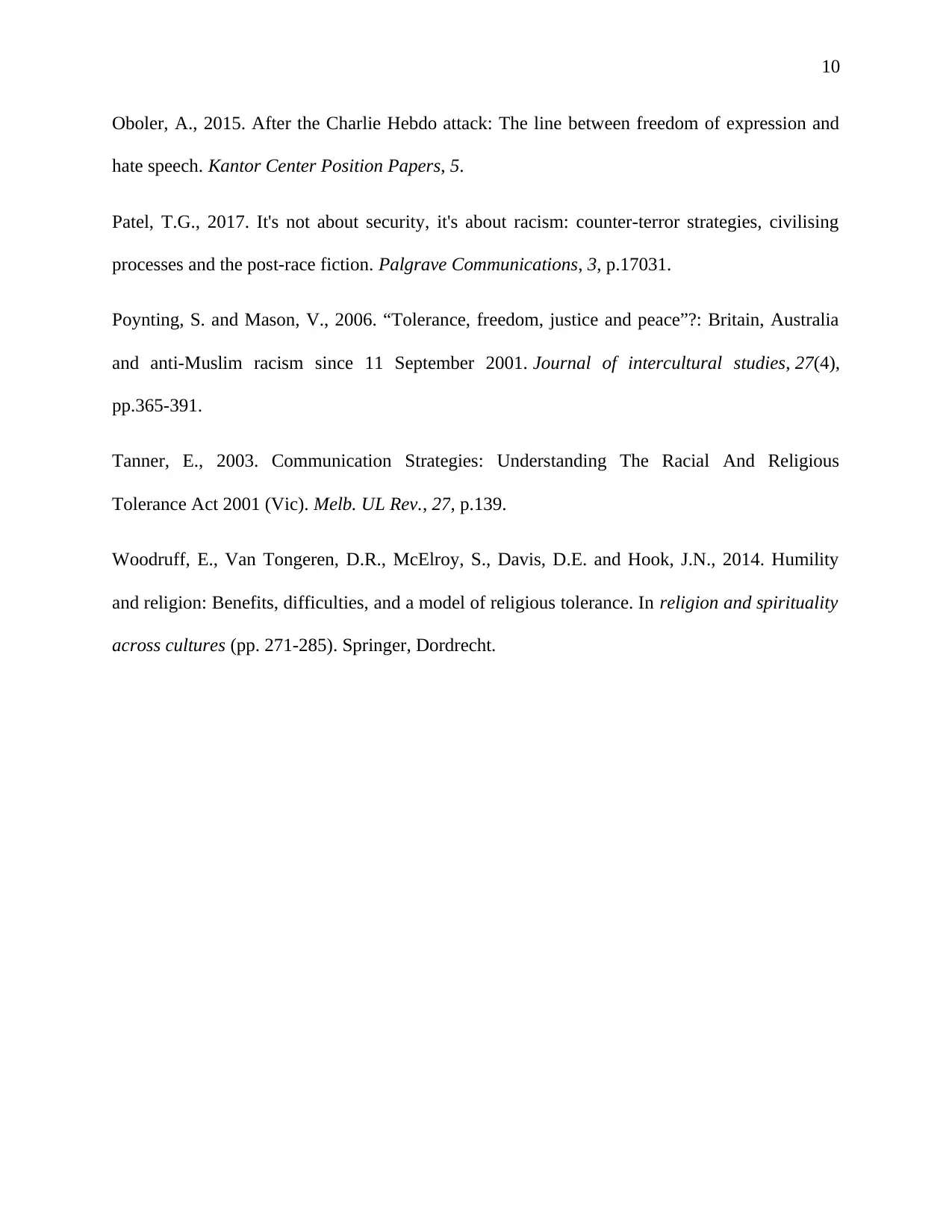
10
Oboler, A., 2015. After the Charlie Hebdo attack: The line between freedom of expression and
hate speech. Kantor Center Position Papers, 5.
Patel, T.G., 2017. It's not about security, it's about racism: counter-terror strategies, civilising
processes and the post-race fiction. Palgrave Communications, 3, p.17031.
Poynting, S. and Mason, V., 2006. “Tolerance, freedom, justice and peace”?: Britain, Australia
and anti-Muslim racism since 11 September 2001. Journal of intercultural studies, 27(4),
pp.365-391.
Tanner, E., 2003. Communication Strategies: Understanding The Racial And Religious
Tolerance Act 2001 (Vic). Melb. UL Rev., 27, p.139.
Woodruff, E., Van Tongeren, D.R., McElroy, S., Davis, D.E. and Hook, J.N., 2014. Humility
and religion: Benefits, difficulties, and a model of religious tolerance. In religion and spirituality
across cultures (pp. 271-285). Springer, Dordrecht.
Oboler, A., 2015. After the Charlie Hebdo attack: The line between freedom of expression and
hate speech. Kantor Center Position Papers, 5.
Patel, T.G., 2017. It's not about security, it's about racism: counter-terror strategies, civilising
processes and the post-race fiction. Palgrave Communications, 3, p.17031.
Poynting, S. and Mason, V., 2006. “Tolerance, freedom, justice and peace”?: Britain, Australia
and anti-Muslim racism since 11 September 2001. Journal of intercultural studies, 27(4),
pp.365-391.
Tanner, E., 2003. Communication Strategies: Understanding The Racial And Religious
Tolerance Act 2001 (Vic). Melb. UL Rev., 27, p.139.
Woodruff, E., Van Tongeren, D.R., McElroy, S., Davis, D.E. and Hook, J.N., 2014. Humility
and religion: Benefits, difficulties, and a model of religious tolerance. In religion and spirituality
across cultures (pp. 271-285). Springer, Dordrecht.
1 out of 10
Related Documents
Your All-in-One AI-Powered Toolkit for Academic Success.
+13062052269
info@desklib.com
Available 24*7 on WhatsApp / Email
![[object Object]](/_next/static/media/star-bottom.7253800d.svg)
Unlock your academic potential
Copyright © 2020–2025 A2Z Services. All Rights Reserved. Developed and managed by ZUCOL.



